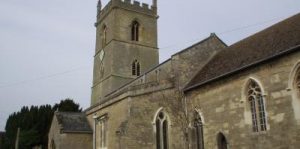
6 bells, 14-3-18 in F
An article written for the church magazine on the ocassion of the rehanging of the bells
The ancient village church of St Mary, Charlton on Otmoor, in Oxfordshire, will ring in the new Millennium in fine style. Almost 450 years after the bells first made it into church records, they have recevied a major overhaul – thanks in great part to the generosity of village residents.
Tower captain Willy Haynes has been delving into the archives to discover more about the bells’ past as well as keeping his own diary of more recent events. Here he tells their fascinating story as recalled in official records of the time..
11th century
First mention of a church appears in a Charter of William the Conquerer of 1081, but the present building dates from around 1200; the church tower’s two lower stages are 13th century, with the top 14th century.
16th century
Survey of church valuables in the reign of Edward VI.
26th day of July, 1553 – item: four greate belles and a saunce bell.
18th century
Churchwardens presentments.
14th day of May, 1789 – we present the treble bell broke but it will be new run immediately. Thomas Cooper, Edward Villiers (recast by John Warner and Sons 1789).
19th century
From the parish register.
July 17th 1895 – upon this day one of the bells in the church tower spoke its last word, its tongue and head falling out from a long-standing fracture, while another struck down (but without killing) Tom Kirby who had incautiously ventured among the bells without giving the ringers due warning.
(This bell was the third by Matthew Bagley 2nd and inscribed Ralph Kirby: John Honor Churchwardens. Bagley made me 1755).
Deanery magazines
1897 – repairs needed. To all interested in the beautiful old church of Charlton it will be a welcome task to try and collect funds for necessary repairs. The tower claims first attention. The bells – one of them broke and the rest far from secure. Let all collect what they can and give to the Rector and Churchwardens. It is intended that the frame shall be arranged to allow a sixth bell being added to complete the peal. Early next year we hope to begin work.
February – work in the tower has already begun, about half the money collected.
March – it has been decided to have a new iron frame which will add to the expense, but the old wooden frame on examintation found too dilapidated to be used again.
April – list of donations totalling £83 4s 2d.
July – collection for the bells has reached over £100.
August – total of £112 15s 9d and halfpenny.
September – £140 9s 4d and halfpenny – the amount of the contract has now been collected but £5 is to be reserved towards the roof of the S. aisle and certain extras have been found necessary.
(Messrs Webb and Bennett bellhangers from Kidlington rehung the bells having a new third bell cast at Whitechapel and on October 13th 1898 a service of rededication took place, with the service followed by ringing with both ringers from Charlton and Kidlington taking part followed by tea in the school, more ringing and back to the school for a supper and a social evening).
The total cost of the work £147 19s 0d paid on November 10th 1898.
In June 1899 the tower roof was releaded. They never added the sixth bell.
A curfew bell rang at 8pm from October until March after a man named Thomas Tryte got lost on the moor and was saved by hearing the church bells ringing. This was rung until World War Two when bell ringing was banned.
20th century
Over the latter years, the bells got harder to ring and nobody wanted to ring them. In 1996 our treasurer Jim Ashley and our late churchwarden Jim Busby came to me Willie Haynes and said: “What’s this £3,000,000 for rehanging bells we read about in the papers?” I replied: “It’s a one-off for the millennium.” Their next question was what was I doing about it and I said I was doing nothing because we had no money to repair the stonework on the outside of the church, let alone rehang the bells. But they turned to me and said: “Come on. Lets have a go and rehang our bells.”
I quickly got estimates and Diocesan approval as we only has a few weeks before the closing date for registering for a grant. This was done. Whites ofAppleton were offered the job which would cost then around £30,000.
Fund raising started in May 1996. In order to qualify for a one-off millennium grant, the parish had to find half the money needed for the entire project. An organ recital was the first event, followed by a classical guitar and violin concert in the church. Local artist William North donated a painting of Charlton church which was later auctioned at the Christmas Bazaar.
Parishoners were asked to give pledges of money, grants were obtained from the Oxford Guild, Bicester Deanery Branch restoration fund, Queens College, Historic Churches, Council for Care of Churches, and Sharpe Trust and an anonymous donor donated the money for a new bell. We got our 50 per cent.
We then had the second appraisal millennium forms to fill up. This was done and we waited (still fund raising) to hear from the Millennium Commission. Alas, the day came on the April 17th1998 when we discovered we had been unsuccessful.
We had a meeting and decided we had gone too far to back out now. So we cut the project down to the bare essentials, just rehanging the five bells and adding the sixth using the money which had been so generously donated. We would then borrow the money and raise the remainder afterwards.
But then on the 14th September 1998 we received a letter saying we had got a millennium grant after all, from the money that had not been used for previous grants. It would amount to 45 per cent, that meant up to £16,777. I made a hasty call to our preist in charge Liz Johnson and Richard Sturch, our Rector. A meeting took place later that day and we were back on track to do the whole job.
The date had already been fixed for the lowering of the bells – 30th September – and to put them on display in the church for a week. A band of helpers offered to assist with the lowering and the raising of the bells – Peter Franklin, of Kidlington, Richard Stevens, of Bicester, Mike Shakespeare, Kirtlington, and Ged Mann, Charlton. The lowering went as planned. Most of the fittings had been removed before and all trap doors had been raised in readiness. A lot of people watched the lowering and also came to look at the bells afterwards in the church during the following week. The bells were then loaded on a lorry with the help of Charlton farmer Franklin Haynes and his fork loader and transported to Whites workshop in Appleton where cracks were found in the crown of the tenor and treble bells. The crowns of the second and fourth were also very thin. Resin pads were fitted internally and externally to strengthen them. After preliminary work, the bells went to Whitechapel for retuning before going back to Appleton to have new headstocks fitted.
The day came when our new bell was being cast at Whitechapel. It was 14th November 1998. We were allowed to take 12 people to watch so a minibus from our local bus company Charlton Services was hired and people that had helped with the project were invited. I was the only one who had been to the bell foundry before. We were made most welcome by the staff. Our bell was being cast with a small bell for the Chung Foundation in Korea and some from Masham in Yorkshire. A photo of the Charlton bell being cast is printed in the Dalesman, a magazine from Yorkshire. The new bell was inscribed in Latin to mark the Queen and Duke of Edinburgh’s golden wedding at the donor’s request.
While the bells were away, electrician Brian Eadle of Gardener and Eadle rewired the tower fitting extra power points and a safety light in the ringing chamber. The bell frame was repainted and Ian Bishop of Merton and myself repaired the wooden louvres in the tower and remade the sound control which I first fitted about 15 years ago.
The bells were back in the church on display in April before going back up in the tower. On the day, Graham Clifton and Mark Walker from Whites came to raise the bells back in the tower. All trapdoors were opened ready, a trusty band of helpers was waiting and by one o’clock only one bell was left to be hoisted up into the tower. Some of the local ladies brought in a cake and a bottle of bubbly to toast the bells on their return.
On April 28th came the try out. The bells rung up in peal and rung in method. The first official ring on the bells was for our May garland service which is one of our services combined with the village school. The church was over full as usual, many people standing outside and afterwards the comments about the bells were overwhelming. I could not help remarking these are not the old Charlton bells any more.
On May 30th, the Bishop of Dorchester the Rt Revd Anthony Russell came to rededicate the bells in a choral evensong with the choir from Queens College, Oxford, our patrons. Once again the church was full. Ringing followed the service and in St Marys House, refreshments were served.
A new band of bell ringers is now being taught and at the time of writing, they are now ringing rounds on their own.
Charlton PCC would like to thank the Millennium Commission, the ODG and trusts for their generosity and all the people in the parish and outside who have contributed and made this millennium project possible, and to Whites and Whitechapel – another job well done by old English craftsmanship.
Written by Willie Haynes – Tower Captain/Churchwarden
Edited by Sue Gonnella.
In 1999 the five bells were re-tuned and rehung with new ringing fittings in the existing six-bell frame. A new bell was added to fill the vacant pit in the frame, the project being jointly funded by the Parish and the Millennium Bell Fund.
| Bell | Diameter | Date | Founder | Note | Weight (Cwts, Qtrs, Lbs) |
| Treble | 2′-51/2“ | 1998 | Whitechapel | D | 5-1-02 |
| Second | 2′-69/16“ | 1789 | John Warner & Sons | C | 5-0-13 |
| Third | 2′-89/16“ | 1746 | Thomas Lester | Bb | 6-0-27 |
| Fourth | 2′-119/16“ | 1898 | Mears & Stainbank | A | 7-1-14 |
| Fifth | 3′-23/4“ | 1681 | Richard Keene | G | 9-1-23 |
| Tenor | 3′-81/8“ | 1681 | Richard Keene | F | 14-3-18 |
